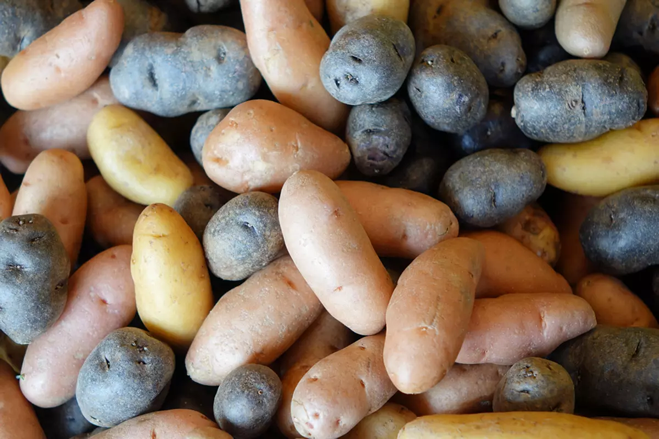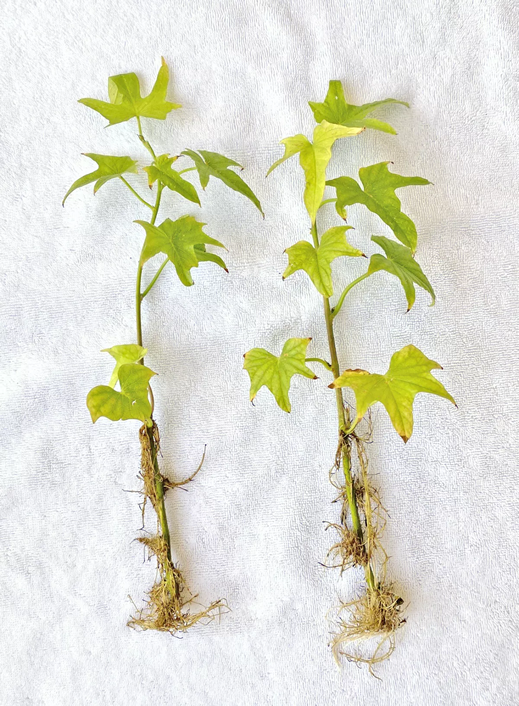Step-by-step guide takes you from buds to spuds
 Potatoes come in a wide variety of colors.(Laura Musikanski / morguefiles.com)
Potatoes come in a wide variety of colors.(Laura Musikanski / morguefiles.com)
By Jodi Bay
Early spring is a time vegetable gardeners begin to plan spring and summer gardens. Looking at seed catalogs, many are selecting seeds for tomatoes, peppers, melons and eggplants.
But what about potatoes? Potatoes are easy to grow, come in various colors and shapes, and they taste much better than store-bought.
Potatoes (Solanum tuberosum, in the nightshade family) and yams (Dioscoreaceae family) are tubers. Tubers are plants that store their food in underground stems. They have multiple “eyes” or buds from which above-ground growth occurs. Sweet potatoes (Ipomoea batatas) are tuberous roots. Tuberous roots store resources in their roots that taper at both ends. They grow in clusters, which are separated for harvest and propagation.
The terms “yams” and “sweet potatoes” are often used interchangeably, but they are very different. Sweet potatoes are orange, tapered at each end and similar in size to a potato. True yams have a thick, barklike skin and a dense, dry flesh in the colors of yellow, white, purple or pink — never orange. They can get as large as 100 pounds and are not grown in San Diego. Even though the vegetable in the grocery store is labeled “yam,” it is a sweet potato. Sometimes, true yams can be found in ethnic grocery stores. Yams must be thoroughly cooked to remove all toxicity.
Potatoes are grown from “seed potatoes” — which are not seeds, but potatoes cut into pieces, with each piece containing two to three buds or “eyes.” They can be started from actual seeds (harvested from potato flowers), but the growing process is longer and the tuber quality varies. Select seed potatoes that are free of pests and diseases and are untreated with bud inhibitor. Grocery store potatoes have been chemically treated to inhibit bud growth and the resultant plant will produce lackluster results. Cut the potatoes into approximately 1-inch pieces with at least one bud per piece. Store them at room temperature for three days to cure the cut areas, ensuring that they are safe from decay.
Being a root vegetable, potatoes grow best in loose, well-draining soil and can be grown in-ground or in a container. For in-ground, select a site that is weed-free and receives four to six hours of daily sunlight. Amend the soil with organic matter and nitrogen fertilizer . University of California research shows that on mineral soils, potatoes need a total of 150 to 300 pounds of nitrogen per acre (0.0525 to 0.105 oz. per square foot). Keep in mind that the amount you’ll need depends on such things as carryover from the last application, soil type, amount of nitrogen in the water and how often you irrigate, so do a soil test before application of any amendments.
In San Diego, potatoes can be planted from March through May and July through August. Plant the seed potatoes 3 inches deep, 6 to 12 inches apart. This gives the plant room to develop larger potatoes. Water once a week, watching that the soil is not overly wet, and fertilize four weeks after sprouts emerge. Turn off watering when the vines turn yellow. Keep them in the ground for two more weeks to cure the potatoes. Potatoes, whole or partially exposed to sunlight, turn green. The green parts are toxic and bitter and should not be eaten. Harvest potatoes by digging them up, and store them in a cool, dark location.

Sweet potatoes propagate by means of new growth from buds and are called “slips.”(Jodi Bay)
To grow potatoes in a container, select a container that is 15 gallons or larger, with drainage holes. Select a fertilizer with 10-10-5 or 12-12-12 ratio of nutrients, always following the label instructions to avoid overfertilizing your new plants. Put 3 to 4 inches of potting soil mixed with vegetable fertilizer in the bottom and place the seed potatoes on top and cover with soil. Tamp down and water.
When the new sprouts are about 3 inches high, plant more seed potatoes and cover with potting soil amended with fertilizer, being careful to not break the stem. Repeat until the container is filled or there are no more seed potatoes. This is called “hilling” and is a way to increase the potato harvest in a small space. This can also be done with in-ground potatoes.
Watch for aphids and early blight (Alternaria) on the potato leaves. Aphids can be removed with a strong stream of water or insecticidal soap. Early blight is a fungal disease identified by circular, black spots on the leaves, and its spores are spread by wind and moisture. It occurs because of warm weather and moist air. Control early blight with copper fungicide sprayed every seven to 10 days until it is under control.
Sweet potatoes are started from slips. Slips are last year’s sweet potatoes that have been re-rooted for this year’s plants. Slips can be purchased from catalogs or you can start your own. Suspend a sweet potato, pointy end down, in a jar filled with water. The water should come halfway up the sweet potato. Once the sprouts emerge, break them off the sweet potato, and put them in a clean jar filled with about 1½ inches of water to continue to form roots. Change the water daily. When the slip is 8 to 12 inches long, it is ready to plant. This whole process takes about 20 to 30 days, depending on temperature. Similar to potatoes, use organic or untreated sweet potatoes that have not been sprayed with root inhibitors. Plant root slips 12 to 18 inches apart in well-draining soil when the soil is warm, about 70 degrees, and the night temperature is above 50 degrees. They will be ready for harvest in three to five months.
Stop watering two weeks before harvest and dig out the potatoes gently using a spading fork. Let dry for a few hours before bringing inside. Sweet potatoes may be affected by nematodes, aphids, flea beetles, leafhoppers and wireworms. Refer to the UC IPM website at ipm.ucanr.edu/agriculture/potato for more information on environmentally friendly methods to manage these pests.
Bay has been a Master Gardener since 2012. She is chair of the Tool Care Committee and an instructor in the Beginning Vegetable Gardening workshops, which teach new gardeners how to grow healthy and bountiful vegetables.

